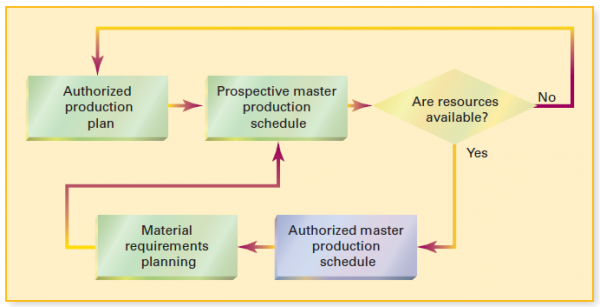Developing a MPS

The objectives in developing an MPS are as follows:
- To maintain the desired level of customer service by maintaining finishedgoods inventory levels or by scheduling to meet customer delivery requirements;
- To make the best use of material, labor and equipment;
- To maintain inventory investment at the required levels.
To reach this objectives, there are 3 steps in preparing a MPA:
- Develop a preliminary MPS,
(1) calculating the projected on-hand inventory and
(2) determining the timing and size of the production quantities of specific products.
- Check the preliminary MPS against available capacity,
- Resolve differences between the preliminary MPS and available capacity.
In some weeks, there may be no MPS quantity for a product because sufficient inventory already exists. For the projected requirements for this week, the scheduler uses whichever is larger—the forecast or the customer orders booked—recognizing that the forecast is subject to error. If actual booked orders exceed the forecast, the projection will be more accurate if the scheduler uses the booked orders because booked orders are a known quantity. Conversely, if the forecast exceeds booked orders for a week, the forecast will provide a better estimate of requirements for that week because some orders are yet to come in.
Preliminary Master Production Schedule
| Part Number | ITEM001 | |||||||
| Lot Size | 30 | |||||||
| On Hand | 20 | |||||||
| Period | 1 | 2 | 3 | 4 | 5 | 6 | ||
| Sales Forecast | 60 | 40 | 60 | 70 | 60 | 50 | ||
| Proj Avail Balance (PAB) | 20 | |||||||
| Master Production Schedule |
To show the process of developing a MPS, an example is used that assumes the product is made to stock, an inventory is kept and the product is made in lots. This process of building an MPS occurs for each item in the family. If the total planned production of all items in the family and the total ending inventory do not agree with the PP, some adjustment to the individual plans must be made so the total production is the same.
| Part Number | ITEM001 | |||||||
| Lot Size | 30 | |||||||
| On Hand | 20 | |||||||
| Period | 1 | 2 | 3 | 4 | 5 | 6 | ||
| Sales Forecast | 60 | 40 | 60 | 70 | 60 | 50 | ||
| Proj Avail Balance (PAB) | 20 | 20 | 10 | 10 | 0 | 0 | 10 | |
| Master Production Schedule | 60 | 30 | 60 | 60 | 60 | 60 |
Once the preliminary mater production schedules are made, they must checked against the available capacity. This process is called rough-cut capacity planning.